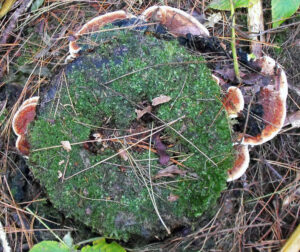
Heterobasidion root disease grows from an infected tree stump. / Photo Credit: Wisconsin DNR
By Kyoko Scanlon, DNR Forest Pathologist, Fitchburg
Kyoko.Scanlon@wisconsin.gov
Fall is a great time to look for mushrooms, including conks from trees infested with Heterobasidion root disease (HRD).
Considered one of the most destructive diseases of conifers in the northern hemisphere, the fungus causing HRD is very difficult to eradicate once established. Infestation of a conifer stand may significantly impact stand management, making early detection of the disease extremely important.
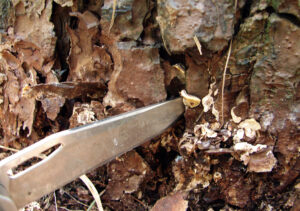
In the early stages, infestation by Heterobasidion root disease can resemble popcorn. / Photo Credit: Wisconsin DNR
In the fall, look for white growth both on new and previous years’ fruit bodies. New HRD fruit bodies are bright white; older fruit bodies also add new, white growth that makes them easier to detect.
HRD fruit bodies can be formed on a stump or at the base of a tree. You may need to scrape away needles and other debris at the base of conifers to find the fruit bodies.
At the initial state, HRD fruit bodies may be small, similar in shape to popcorn. Under favorable conditions, fruit bodies grow into a shelf-like conk that becomes light gray to brown on the upper surface.
HRD fruit bodies are usually found near the ground line, but they may be found higher than 1 foot from the ground. Also, they may grow flat. Although they can be found in many different shapes and sizes, the undersides of the fruit bodies are pores, not gills.
If you find HRD fruit bodies, contact a Wisconsin Department of Natural Resources (DNR) Forest Health specialist to report them.
For more information about preventing HRD infestation or about Wisconsin’s HRD guidelines, visit the DNR HRD webpage.
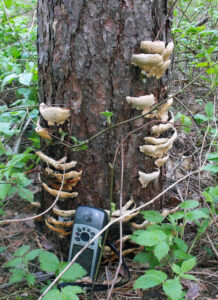
Heterobasidion root disease fruit bodies can grow as shelf-like shapes higher than one foot up the tree’s main stem. / Photo Credit: Wisconsin DNR
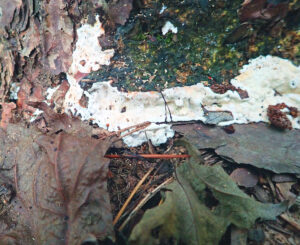
A flat fruit body of Heterobasidion root disease grows on the ground line. / Photo Credit: Wisconsin DNR
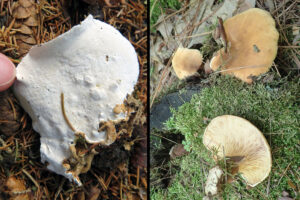
Left: Upon closer inspection, the underside of a Heterobasidion root disease fruit body shows pores, not gills. Right: A lookalike fungus that is not Heterobasidion root disease shows gills, not pores, on its underside. / Photo Credit: Wisconsin DNR
